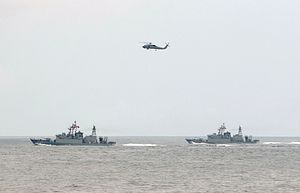On Wednesday, the Taiwanese military held its largest live-fire coastal drills in five years. The Republic of China Air Force (ROCAF) and Republic of China Navy (ROCN) held joint air-sea exercises off Taiwan’s eastern coast as part of the annual Han Kuang exercises.
As many as 22 ROCAF aircraft and 22 ROCN ships participated in the exercises, which were designed to simulate operations against an adversary force attempting to push toward Taiwan from the sea and air in the Taiwan Strait. Taipei’s exercises are designed to repel attack by the mainland.
According to Taiwan’s Central News Agency, ROCN ships participating in the exercises included the two decommissioned U.S. Navy Oliver Hazard Perry-class frigates that had been received by Taiwan in 2017.
“The warships included two Oliver Hazard Perry-class frigates, La Fayette-class frigates, Ching Chiang-class patrol ships, Tuo Chiang-class corvettes and Kuang Hua-class missile boats, while warplanes like F-16s, Mirage 2000s and indigenous defense fighter jets were also dispatched to take part in the joint exercise,” a ministry official said, according to the South China Morning Post. The ROCN operates other surface combatant vessels, including Kidd-class destroyers.
Wednesday’s joint exercises involved the use of anti-air, anti-ship, and anti-submarine weapons. Taiwan operates a wide range of imported and indigenous missiles.
The Taiwanese military uses a “resolute deference” strategy comprising capabilities across multiple domains, with the objective of “delivering deterrence and defense to keep the enemy at bay,” according to its 2017 Quadrennial Defense Review.
“With a focus on integrating joint operational capabilities, the ROC Armed Forces continues to improve its joint operational training, establish precise logistic capabilities, enact policy reforms for mobilizing reservists, and generate a warrior spirit in the force, in order to ensure successful accomplishment of defense missions for our nation,” the Review had noted, underscoring the importance of joint operations.
A recent U.S. Department of Defense assessment of China’s military capabilities and strategy noted that “Although China advocates for peaceful unification with Taiwan, China has never renounced the use of military force, and continues to develop and deploy advanced military capabilities needed for a potential military campaign.”
The report also expressed concern that the Chinese People’s Liberation Army’s reform since 2015 has improved its ability to sustain joint operations via the new theater commands. The Eastern Theater Command would play the primary role in any future contingency across the Taiwan Strait.
Since 2016, relations between the mainland and Taiwan have deteriorated.

































